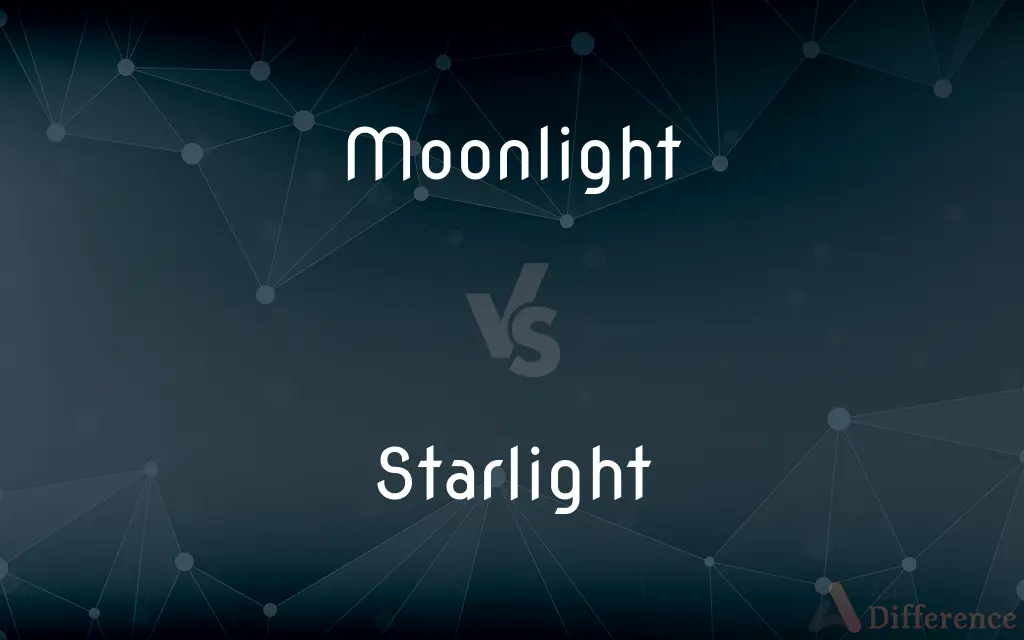Moonlight vs. Starlight — What's the Difference?
Edited by Tayyaba Rehman — By Urooj Arif — Updated on April 2, 2024
Moonlight is reflected sunlight off the moon's surface, providing a brighter, more uniform glow, while starlight is direct light from stars, dimmer and varying in color based on distance and size.

Difference Between Moonlight and Starlight
Table of Contents
ADVERTISEMENT
Key Differences
Moonlight, the light that reaches Earth from the Moon, is actually sunlight reflected off the Moon's surface. This reflection gives moonlight its characteristic bright but soft glow, which can vary in intensity with the Moon's phases. In contrast, starlight is the direct light emitted by stars other than our Sun. It reaches Earth from vast distances, appearing much dimmer than moonlight. The intensity and color of starlight vary significantly among stars, depending on their size, age, and distance from Earth.
Moonlight has a significant impact on Earth, influencing the behavior of animals and plants, and affecting human culture and mythology. Its relatively uniform and diffuse light can illuminate landscapes on clear nights. Starlight, while not as bright or influential on terrestrial environments, fascinates astronomers and has been crucial in our understanding of the universe. The study of starlight through spectroscopy reveals important information about a star’s composition, temperature, and motion.
Culturally, moonlight has been a symbol of romance, mystery, and transformation in various mythologies and arts. Its influence is seen in literature, music, and folklore, where it often represents beauty, change, or melancholy. Starlight, by comparison, symbolizes vastness, eternity, and the mysteries of the universe. It has inspired countless works of art and literature, invoking a sense of wonder about the cosmos.
From a scientific perspective, the study of moonlight helps in understanding lunar properties and the dynamics of Earth-Moon interactions. Starlight, on the other hand, is a fundamental tool in astronomy that helps scientists explore the properties of distant celestial bodies, the structure of galaxies, and the history of the universe. Techniques like photometry and spectroscopy allow astronomers to analyze starlight and gather data about the universe's most remote objects.
Despite their differences, both moonlight and starlight share the commonality of influencing human perception of the night sky. They have guided explorers, inspired artists, and intrigued scientists throughout history. Their beauty and mystery continue to inspire curiosity and wonder about our place in the universe.
ADVERTISEMENT
Comparison Chart
Source
Reflected sunlight from the Moon’s surface.
Direct light from stars.
Brightness
Brighter and more uniform, varying with moon phases.
Generally dimmer, varies among stars.
Color
Typically pale white to yellowish, depending on atmosphere.
Varies widely, from red to blue, indicating temperature and age.
Impact on Earth
Affects animal behavior and plant growth; influences tides.
Less direct impact but crucial for navigation and astronomy.
Cultural Significance
Symbolizes romance, mystery, and transformation.
Represents vastness, eternity, and curiosity.
Scientific Use
Studied for understanding the Moon and Earth-Moon relations.
Analyzed to learn about the universe’s composition and structure.
Compare with Definitions
Moonlight
Used in understanding lunar characteristics and Earth-Moon dynamics.
Scientists study moonlight to assess the Moon's albedo.
Starlight
Symbolizes eternity, vastness, and the mysteries of the universe.
Sailors once navigated the seas guided by starlight.
Moonlight
The light reflected from the Moon's surface to the Earth.
The moonlight bathed the garden in a soft, silver glow.
Starlight
Light emitted by stars, reaching Earth after traveling vast distances.
Starlight from distant galaxies takes millions of years to reach us.
Moonlight
Symbolically represents beauty, romance, and mystery.
Many poets have drawn inspiration from the serene beauty of moonlight.
Starlight
Represents the collective light of stars visible in the night sky.
The campsite was illuminated only by starlight.
Moonlight
Affects ecological and biological processes on Earth.
Certain species of coral spawn synchronously by moonlight.
Starlight
Crucial in the study of the universe's composition and celestial dynamics.
Through starlight analysis, astronomers can determine a star's elements.
Moonlight
A natural illumination in the night provided by the Moon.
They enjoyed a walk under the bright moonlight.
Starlight
Varies in intensity and color, indicating a star’s properties.
Red starlight suggests a cooler star, while blue indicates a hotter one.
Moonlight
Moonlight consists of mostly sunlight (with little earthlight) reflected from the parts of the Moon's surface where the Sun's light strikes.
Starlight
Starlight is the light emitted by stars. It typically refers to visible electromagnetic radiation from stars other than the Sun, observable from Earth at night, although a component of starlight is observable from Earth during daytime.
Moonlight
The light reflected from the surface of the moon.
Starlight
Light from a star or stars.
Moonlight
To work at another job, often at night, in addition to one's full-time job.
Starlight
Light emitted from stars other than the Sun.
Moonlight
The light reflected from the Moon.
Starlight
The light given by the stars.
Nor walk by moon,Or glittering starlight, without thee is sweet.
Moonlight
To work on the side (at a secondary job), often in the evening or during the night.
Starlight
Lighted by the stars, or by the stars only; as, a starlight night.
A starlight evening and a morning fair.
Moonlight
(by extension) To engage in an activity other than what one is known for.
Starlight
The light of the stars
Moonlight
To carry out undeclared work.
Moonlight
The light of the moon.
Moonlight
To work at a second job in addition to one's main occupation; - often done at night.
Moonlight
The light of the moon;
Moonlight is the smuggler's enemy
The moon was bright enough to read by
Moonlight
Work a second job, usually after hours;
The law student is moonlighting as a taxi driver
Common Curiosities
Why is moonlight brighter than starlight?
Moonlight is brighter because it's sunlight reflected off the Moon’s surface, which is much closer to Earth than stars.
What can scientists learn from starlight?
Scientists analyze starlight to understand a star's properties, such as temperature, composition, and motion, and to study the universe's structure.
Can starlight vary in color, and why?
Yes, starlight varies in color based on the star’s temperature, age, and composition, with cooler stars appearing red and hotter stars appearing blue.
Why is starlight important for navigation?
Historically, sailors and explorers used starlight for navigation, using the positions of stars to guide their paths across the seas.
What is the significance of the color of starlight?
The color of starlight indicates a star’s temperature, with red being cooler and blue being hotter, also implying information about the star’s lifecycle.
How does moonlight affect Earth?
Moonlight influences animal behaviors, plant growth, and tidal patterns, among other ecological and biological processes.
Has moonlight had a significant impact on culture?
Yes, moonlight has deeply influenced human culture, symbolizing beauty, romance, mystery, and transformation across various mythologies and arts.
Are there any plants or animals that specifically react to moonlight?
Yes, certain species, such as some corals and nocturnal animals, have behaviors or life processes that are triggered or influenced by moonlight.
How does the phase of the Moon affect moonlight?
The phase of the Moon affects the amount of sunlight reflected towards Earth, influencing the brightness and appearance of moonlight.
What tools do astronomers use to study starlight?
Astronomers use telescopes equipped with spectrometers and photometers to analyze the composition, temperature, and other properties of starlight.
Share Your Discovery

Previous Comparison
Starts vs. Start
Next Comparison
Tyr vs. YmirAuthor Spotlight
Written by
Urooj ArifUrooj is a skilled content writer at Ask Difference, known for her exceptional ability to simplify complex topics into engaging and informative content. With a passion for research and a flair for clear, concise writing, she consistently delivers articles that resonate with our diverse audience.
Edited by
Tayyaba RehmanTayyaba Rehman is a distinguished writer, currently serving as a primary contributor to askdifference.com. As a researcher in semantics and etymology, Tayyaba's passion for the complexity of languages and their distinctions has found a perfect home on the platform. Tayyaba delves into the intricacies of language, distinguishing between commonly confused words and phrases, thereby providing clarity for readers worldwide.
















































